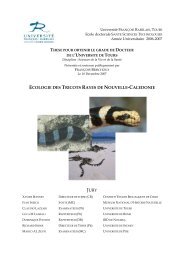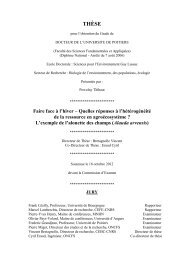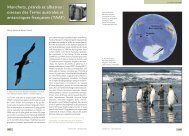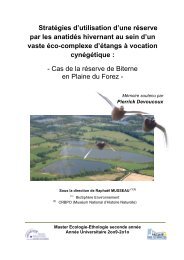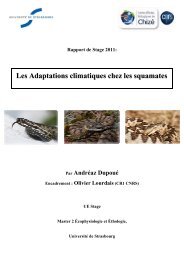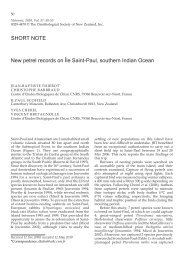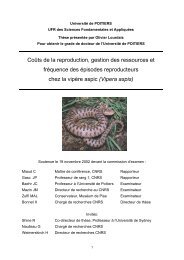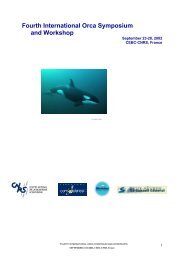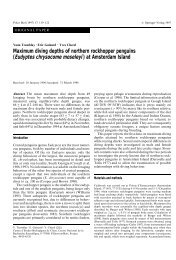Forçage environnemental et prédateurs marins ... - Cebc - CNRS
Forçage environnemental et prédateurs marins ... - Cebc - CNRS
Forçage environnemental et prédateurs marins ... - Cebc - CNRS
Create successful ePaper yourself
Turn your PDF publications into a flip-book with our unique Google optimized e-Paper software.
Fig. 3. Climate changes. (A) Southern Annular Mode (SAM) (r 2 0.65; P <br />
0.001) as defined in ref. 9. (B) Southern Oscillation Index (SOI) (r 2 0.08; P <br />
0.03). (C) Average annual air temperatures recorded at the Dumont d’Urville<br />
m<strong>et</strong>eorological station (1956–2002) (r 2 0.01; P 0.47). (D) M<strong>et</strong>hanesulfonic<br />
acid concentration (MSA) (r 2 0.32; P 0.001) as a proxy for sea ice extent<br />
from an ice core in East Antarctica (13). Values were redrawn from ref. 13. (E)<br />
Sea ice season length (SIL) for the sector 136°E to 142°E and north of 65°S (r 2 <br />
0.13; P 0.09). Data are from ref. 16; updates were kindly provided by C. L.<br />
Parkinson (NASA Goddard Space Flight Center, Greenbelt, MD). Regression<br />
lines indicate significance of the trends (solid line, P 0.05; dotted line, P <br />
0.05).<br />
disproportionately negatively affected by current climate<br />
changes.<br />
Materials and M<strong>et</strong>hods<br />
Phenological Data. Since 1950, the dates of first arrival of the nine<br />
seabird species breeding in Antarctica and the dates of laying of first<br />
eggs from five of these species have been recorded by ornithologists<br />
wintering almost each year at the Dumont d’Urville Station in<br />
Adélie Land, Antarctica, generating the longest phenological data<br />
s<strong>et</strong> available for Antarctic species. First arrival dates and first<br />
egg-laying dates were recorded as part of a long-term study of top<br />
predators at Adélie Land. The Antarctic p<strong>et</strong>rel (Thalassoica antarctica)<br />
is the only Antarctic seabird species not breeding at<br />
Dumont d’Urville. However, a large breeding colony (nearly 4,000<br />
breeding pairs) is situated 110 km from Dumont d’Urville (24),<br />
and the species is regularly seen in the surroundings of the station.<br />
Consequently, first arrival dates for all of the nine species of<br />
Antarctic seabirds were used in the analysis. For three species<br />
(southern giant p<strong>et</strong>rel, Macronectes giganteus; southern fulmar,<br />
Fulmarus glacialoides; and Wilson’s storm p<strong>et</strong>rel, Oceanites oceanicus),<br />
egg-laying dates were not recorded either because these<br />
species breed in low numbers, and access to colonies was limited to<br />
minimize disturbance, or because of their cryptic nesting. Because<br />
all breeding colonies are situated in the vicinity of the research<br />
station and because the observer was permanently in the field<br />
(weather permitting), we are very confident in the precision of<br />
Fig. 4. Phenological changes and sea ice extent. (A) Dates of first arrival<br />
advanced significantly with increasing sea ice extent for the southern fulmar<br />
(r 2 0.17; P 0.02), Cape p<strong>et</strong>rel (r 2 0.24; P 0.004), Wilson’s storm p<strong>et</strong>rel<br />
(r 2 0.17; P 0.02), and south polar skua (r 2 0.16; P 0.03). (B) Dates of<br />
laying of first eggs advanced significantly with increasing sea ice extent for the<br />
emperor penguin (r 2 0.15; P 0.02), Adélie penguin (r 2 0.12; P 0.05), and<br />
Cape p<strong>et</strong>rel (r 2 0.19; P 0.04). Solid lines indicate significant (P 0.05)<br />
regressions. Abbreviations are as described in the legend of Fig. 2.<br />
arrival and egg-laying dates. Although the m<strong>et</strong>hodological uncertainties<br />
for the observations have not been quantified, the precision<br />
of the observations is probably 1 day.<br />
Statistical Analyses. To correct for fluctuations in the calendar<br />
date of the vernal equinox over the study period, phenological<br />
events were reported and expressed as the time elapsed since the<br />
vernal equinox for each year of the data s<strong>et</strong> (25). In the<br />
m<strong>et</strong>aanalysis, the slopes of regressions were considered as<br />
measures of effect size, and Kolmogorov–Smirnov tests confirmed<br />
that the slopes were distributed normally (P 0.66).<br />
We thank all of the people involved in the monitoring programs of<br />
seabirds in Terre Adélie since 1950; C. L. Parkinson for providing<br />
updates of the sea ice season length data; Météo France for the<br />
m<strong>et</strong>eorological data of Dumont d’Urville; A. Lagarde and D. Besson for<br />
data management; and J. Croxall, C.-A. Bost, O. Chastel, Y. Cherel, M.<br />
Nevoux, and D. Pinaud for comments on the manuscript. This work was<br />
supported over the past 55 years by Expéditions Polaires Françaises,<br />
Institut Polaire Paul Emile Victor (Research Program 109), and Terres<br />
Australes <strong>et</strong> Antarctiques Françaises.<br />
6250 www.pnas.orgcgidoi10.1073pnas.0510397103 Barbraud and Weimerskirch



